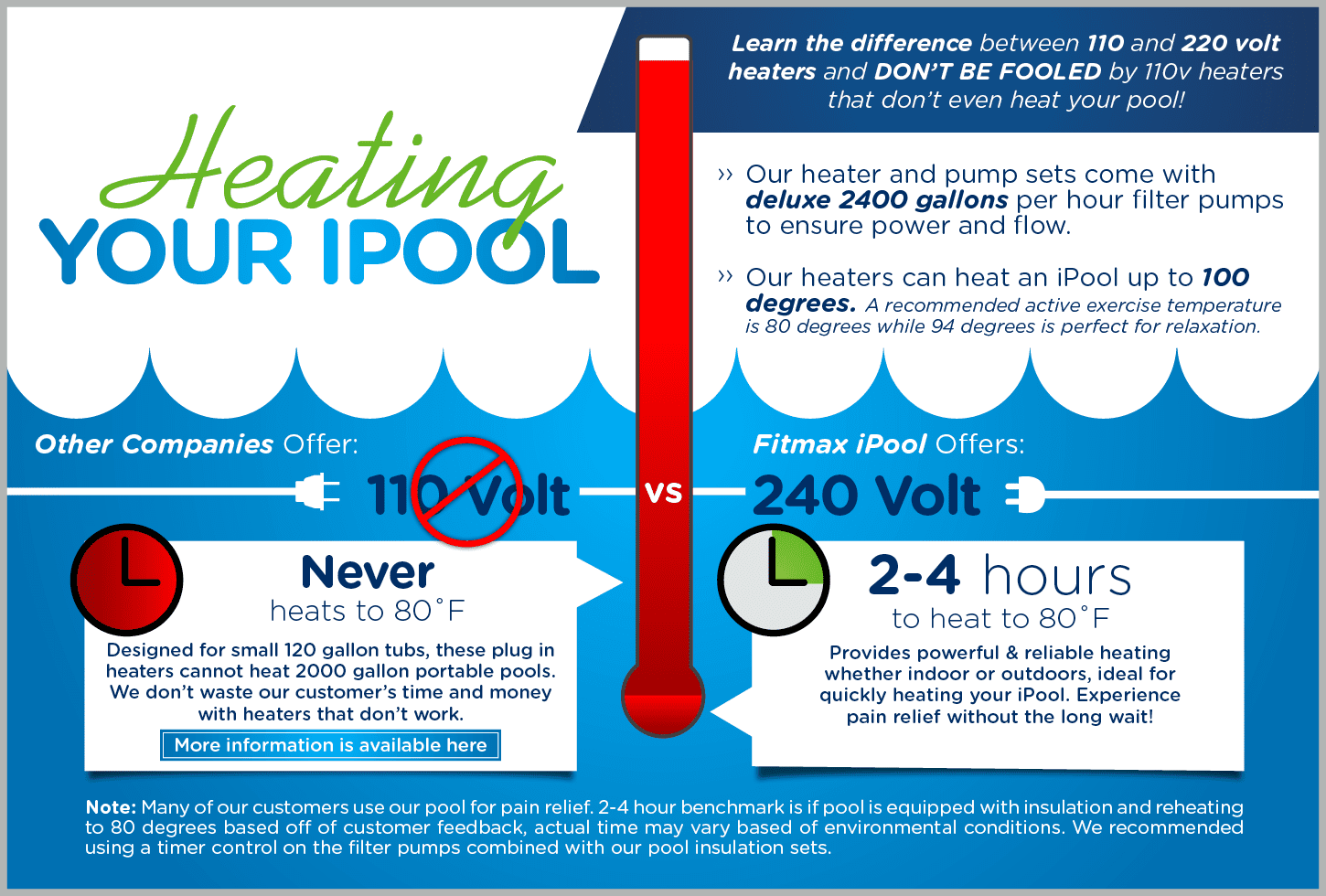How To Determine Heating Time For Your Pool


![]()
Many of our customers wish to enjoy a warm therapy pool and one of the big benefits our therapy pools offer is the advantage of swimming in one of the world’s smallest true swimming pools. We are often asked by customers what is the average heating time for a therapy pool for our unique size. Generally heating time is determined by several factors the main factor being the power of the heater you are using, the size of the pool itself, and the amount of heat loss you experience due to evaporation and ambient air temperature.
We use 220 volt electric heaters instead of 110v plug in heaters. This is because the 220 volt heater is more reliable and powerful than the 110v. The 220v electric heater generates about 37,000 BTU. BTU or British Thermal Unit refers to a unit of energy needed to heat a pound of water one degree. Our largest therapy pool, the Fitmax iPool 3-D, is 2200 gallons or 18,260 pounds of water so it would require at least 18,260 BTU an hour to raise it one degree. Unfortunately, 110v heaters generally offer only about 5,118 BTU an hour. This is not only insufficient when you factor in natural heat loss the pool may never heat to a usable temperature at all.
![]()
For example, cold tap water is about 50°F. If you want to heat our iPool 3-D from 50 degrees to about 80°F which is a comfortable swimming temperature used by fitness facilities, athletes, and Olympic games you can determine how long it will take by multiplying the weight of the pool with your target temperature and then divide by your BTU rate. This is what it looks like written out:
2200 gallons x 8.34 (lbs in a gallon) x 30 (difference between 80 degrees and 50 degrees)
___________________________
37,000 (BTU per hour for our 11kw heater)
You would need roughly 15 hours in this case to heat the pool the first time.
Most of our customers simply run the heater overnight and check it again in the morning.
If you had used a plug in 110v heater and we apply our equation again:
2200 gallons x 8.34 (lbs in a gallon) x 30 (difference between 80 degrees and 50 degrees)
___________________________
5118 (BTU per hour for a typical 110v electric heater)
You would be looking at 107 hours, basically five days uninterrupted to heat the pool 30 degrees, assuming there is no heat loss. In real life this is never the case. Once you factor in heat loss, the 110v heater does nothing and the water stays cold even after five days of waiting.
We’ve seen some knock off versions of our pools on the market paired with cheap 110v heaters. It is something we are strongly against because we feel it is deceptive to the customer to offer something that does not really work. We want our customers to be able to use and enjoy our products as much as possible. Our testimonials, customer service, and product lifetime warranty all reflect this philosophy.
![]() Now given it would take five days to heat the pool in perfect conditions, once we factor in actual heat loss the 110v becomes pretty infeasible. Heat loss is dependent on three main factors: the temperature difference between the air and surface water of the pool, the total surface area of the pool, and the heat loss factor due to wind velocity. Let’s assume that it is 40 degrees outside in the morning. If you have the pool at 50 degrees initially and you are in a partially sheltered area you would need to multiply everything together to get your actual surface heat loss:
Now given it would take five days to heat the pool in perfect conditions, once we factor in actual heat loss the 110v becomes pretty infeasible. Heat loss is dependent on three main factors: the temperature difference between the air and surface water of the pool, the total surface area of the pool, and the heat loss factor due to wind velocity. Let’s assume that it is 40 degrees outside in the morning. If you have the pool at 50 degrees initially and you are in a partially sheltered area you would need to multiply everything together to get your actual surface heat loss:
5 (btu/hr surface heat loss factor estimate for moderate winds) x 10 degrees (difference between 40 and 50 degrees of ambient air and pool water) x 70 (surface area of an iPool ft squared)
= 3500 btu would be lost per hour
Although this would not really affect the 240v heater, the 110v heater is only running at 32% efficiency now in 40 degree weather. This means in outdoor conditions running the heater is pointless. Even worse, if your pool water was at 80 degrees already, the heater won’t be strong enough to keep your pool warm in this scenario because the btu loss would be so high. Similarly if you installed the pool indoors in a garage or basement it may take days to heat your pool, once any significant temperature difference hits you will have to start all over again.
This performance difference is why we do not pair our therapy pools up with 110v heaters. Frankly, 110v heaters are designed for small 120 gallon tubs not therapy pools. With a 240v heater you don’t need to run the heater constantly 24/7. Our filter pump heater sets come with timers so you can just use the heater to spike the temperature a few hours before. It is reliable, easy to use, and saves you time.
Keep in mind that these numbers are approximations since environmental conditions vary and play a pretty big factor, but they can you give you a rough guideline what to expect when heating our pool indoors or outdoors. We created the Fitmax iPool and Therapy Pool to be convenient and effective. Our goal is to offer our customers the benefits of a private and personal heated therapy swimming pool so they don’t have to drive to a local rec center every time they want to go for a swim. The electric heating set up does require the assistance of an electrician but it is relatively easy and provides a more reliable system than what is normally available on the market. Our heated therapy pools are our most popular line of products for good reason. We hope you will consider taking a look at what many patients have used to experience both pain and stress relief in the comfort and convenience of their own home.



